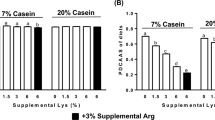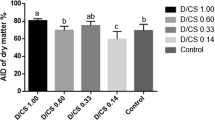Abstract
Background/Objectives:
To ascertain if the form of dietary nitrogen (free amino acids (AA), small peptides, or intact protein) affects the endogenous nitrogen containing substances lost from the upper digestive tract of humans.
Subjects/Methods:
Digesta were collected via a naso-ileal tube from the terminal ileum of 16 adult humans in a single parallel study following an acute feeding regimen. Subjects were given an iso-nitrogenous and isocaloric test meal containing 150 g of casein (CAS) (n=6), enzyme-hydrolyzed casein (HCAS) (n=5) or crystalline AA (n=5) dissolved in 550 ml of water, as the sole sources of nitrogen.
Results:
The mean concentrations and flows of total nitrogen, protein nitrogen, and soluble protein nitrogen passing the terminal ileum were significantly higher (P <0.01) for the CAS and HCAS test-meal groups compared to the AA meal group. Dietary CAS and HCAS had a considerable influence on digesta mucin concentrations and flows compared to free AA (+41%). Only 3–4% of the total nitrogen remained unidentified.
Conclusions:
The form of dietary nitrogen (protein, small peptides or free AA) had an acute effect upon the secretion or reabsorption of endogenous proteins in the small intestine of healthy humans, as evident from significant differences in both the quantity and composition of the proteins found in digesta at the end of the ileum.
This is a preview of subscription content, access via your institution
Access options
Subscribe to this journal
Receive 12 print issues and online access
$259.00 per year
only $21.58 per issue
Buy this article
- Purchase on Springer Link
- Instant access to full article PDF
Prices may be subject to local taxes which are calculated during checkout
Similar content being viewed by others
References
Wapnir RA, Teichberg S . Regulation mechanisms of intestinal secretion: implications in nutrient absorption. J Nutr Biochem 2002; 13: 190–199.
Moughan PJ, Cranwell PD, Darragh AJ, Rowan AM . The domestic pig as a model animal for studying digestion in humans. In: Souffrant WB, Hagemeister H (eds). Vith International Symposium on Digestive Physiology in Pigs, Proceedings Vols 1 and 2. EAAP Publication: Dummerstorf, Germany 1994; pp 389–396.
Krawielitzki K, Kreienbring F, Zebrowska T, Schadereit R, Kowalczyk J . Estimation of N absorption, secretion and reabsorption in different intestinal sections of growing pigs using the N-15 isotope dilution method. In: Souffrant WB, Hagemeister H (eds). VIth International Symposium on Digestive Physiology in Pigs, Proceedings Vols 1 and 2. EAAP Publication: Dummerstorf, Germany, 1994; pp 79–82.
Nasset ES, Ju JS . Mixture of endogenous and exogenous protein in the alimentary tract. J Nutr 1961; 74: 461–465.
Caine WR, Tamminga S, Sauer WC, Verstegen MWA, Schulze H . Bacterial contributions to total and endogenous recoveries of nitrogen and amino acids in ileal digests of newly weaned piglets fed protease-treated soybean meal. Livestock Prod Sci 1999; 57: 147–157.
Moughan PJ, Rutherfurd SM . Gut luminal endogenous protein: implications for the determination of ileal amino acid digestibility in humans. Brit J Nutr 2012; 108: S258–S263.
Moughan PJ . Amino acid availability: aspects of chemical analysis and bioassay methodology. Nutr Res Rev 2003; 16: 127–141.
Fuller MF, Tome D . In vivo determination of amino acid bioavailability in humans and model animals. J AOAC Intl 2005; 88: 923–934.
Moughan PJ, Souffrant WB, Hodgkinson SM . Physiological approaches to determining gut endogenous amino acid flows in the mammal. Arch Anim Nutr 1998; 51: 237–252.
Millward DJ, Garlick PJ, James WPT, Sender PM, Waterlow JC . Protein turnover. In: Cole DJA, Boorman KN, Buttery PJ, Lewis D, Neale RJ, Swan H (eds). Protein Metabolism and Nutrition. London: European Association of Animal Production. Butterworths: London, 1976, pp 49–69.
Snook JT, Meyer JH . Response of digestive enzymes to dietary protein. J Nutr 1964; 82: 409–414.
Schneeman BO . Digestive enzyme activities from the pancreas in response to diet. In: Laplace JP, Corring T, Rerat A (eds). Physiologie Digestive Chez le Porc. Institut National de la Recherche Agronomique: Paris, 1982, pp 125–131.
Pedersen C, Boisen S, Fernandez JA . Studies on the effect of dietary crude protein supply on the composition of ileal endogenous crude protein loss in growing pigs. ACTA Agr Scand A-An 2002; 52: 141–149.
Deglaire A, Bos C, Tomé D, Moughan PJ . Ileal digestibility of dietary protein in the growing pig and adult human. Brit J Nutr 2009; 102: 1752–1759.
Miner-Williams W, Deglaire A, Benamouzig R, Fuller MF, Tome D, Moughan PJ . Endogenous proteins in terminal ileal digesta of adult subjects fed a casein-based diet. Am J Clin Nutr 2012; 96: 508–515.
Miner-Williams W, Moughan PJ, Fuller MF . Endogenous components of digesta protein from the terminal ileum of pigs fed a casein based diet. J Agr Food Chem 2009; 57: 2072–2078.
Deglaire A, Fromentin C, Fouillet H, Airinei G, Gaudichon C, Boutry C et al. Hydrolyzed dietary casein as compared with the intact protein reduces postprandial peripheral, but not whole-body, uptake of nitrogen in humans. Am J Clin Nutr 2009; 90: 1011–1022.
AOAC. Official method of analysis for amino acids. Official methods of analysis of association of official analytical chemists international. Association of Official Analytical Chemists International: Gaithersburg MD, 2003.
AOAC. Official Method for protein, (Dumas method), 968.06. Official methods of analysis of association of official analytical chemists international 2000.
Wunsche J, Volker T, Souffrant WB, Borgmann E . Assessment of the bacteria-N proportions in feces and differently obtained ileal digesta of pigs. Arch Tierernahr 1991; 41: 703–716.
Czerkawski JW . Methods for determining 2-6-diaminopimelic acid and 2-aminoethylphosphonic acid in gut contents. J Sci Food Agr 1974; 25: 45–55.
Bradford MM . Rapid and sensitive method for quantitation of microgram quantities of protein utilizing principle of protein-dye binding. Anal Biochem 1976; 72: 248–254.
Lien KA, Sauer WC, He JM . Dietary influences on the secretion into and degradation of mucin in the digestive tract of monogastric animals and humans. J Anim Feed Sci 2001; 10: 223–245.
Chaney AL, Marbach EP . Modified reagents for determination of urea and ammonia. Clin Chem 1962; 8: 130–132.
Iversen GR, Norpoth H . Analysis of Variance. Sage: Thousand Oaks, CA, 1987.
Bracht GH, Glass GV . The external validity of experiments 1. Am Educ Res J 1968; 5: 437–474.
Skilton GA, Moughan PJ, Smith WC . Determination of endogenous amino-acid flow at the terminal ileum of the rat. J Sci Food Agr 1988; 44: 227–235.
Moughan PJ, Butts CA, van Wijk H, Rowan AM, Reynolds GW . An acute ileal amino acid digestibility assay is a valid procedure for use in human ileostomates. J Nutr 2005; 135: 404–409.
Stern J, Bruwer M, Huber FX, Decker-Baumann C . Metabolic consequences after ileostomy. Chirurg 1999; 70: 627–634.
Fuller MF, Milne A, Harris CI, Reid TMS, Keenan R . Amino-acid losses in ileostomy fluid on a protein-free diet. Am J Clin Nutr 1994; 59: 70–73.
Modigliani. R, Rambaud JC, Bernier JJ . Method of intraluminal perfusion of human small-intestine.1. principle and technique. Digestion 1973; 9: 176–192.
Deglaire A, Bos C, Airinei G, Luengo C, Benamouzig R, Fauquant J et al. Postprandial metabolic utilization of intact and hydrolyzed casein in humans. FASEB J 2007; 21: A333–A333.
Deglaire A . Gut endogenous protein flows and post prandial metabolic utilization of dietary amino acids in simple stomached animals and humans [Doctor of Philosophy]. PhD Thesis. Massey University: Palmerston North, 2008.
Moughan PJ, Butts CA, Rowan AM, Deglaire A . Dietary peptides increase endogenous amino acid losses from the gut in adults. Am J Clin Nutr 2005; 81: 1359–1365.
Claustre J, Toumi F, Trompette A, Jourdan G, Guignard H, Chayvialle JA et al. Effects of peptides derived from dietary proteins on mucus secretion in rat jejunum. Am J Physiol-Gastr L 2002; 283: G521–G528.
Darragh AJ, Moughan PJ, Smith WC . The effect of amino-acid and peptide alimentation on the determination of endogenous amino-acid flow at the terminal ileum of the rat. J Sci Food Agr 1990; 51: 47–56.
Butts CA, Moughan PJ, Smith WC, Carr DH . Endogenous lysine and other amino-acid flows at the terminal ileum of the growing pig (20 kg bodyweight) - the effect of protein-free, synthetic amino-acid, peptide and protein alimentation. J Sci Food Agr 1993; 61: 31–40.
Deglaire A, Moughan PJ, Rutherfurd SM, Bos C, Tomé D . Feeding dietary peptides to growing rats enhances gut endogenous protein flows compared with feeding protein-free or free amino acid-based diets. J Nutr 2007; 137: 2431–2436.
Rowan AM, Moughan PJ, Wilson MN . The flows of deoxyribonucleic-acid and diaminopimelic acid and the digestibility of dietary fiber components at the terminal ileum, as indicators of microbial activity in the upper digestive-tract of ileostomized pigs. Anim Feed Sci Tech 1992; 36: 129–141.
Robinson PH, Fadel JG, Ivan M . Critical evaluation of diaminopimelic acid and ribonucleic acid as markers to estimate rumen pools and duodenal flows of bacterial and protozoal nitrogen. Can J Anim Sci 1996; 76: 587–597.
Sissons JW . Digestive enzymes of cattle. J Sci Food Agr 1981; 32: 105–114.
Ushida Y, Shimokawa Y, Toida T, Matsui H, Takase M . Bovine alpha-lactalbumin stimulates mucus metabolism in gastric mucosa. J Dairy Sci 2007; 90: 541–546.
Ushida Y, Shimokawa Y, Matsumoto H, Toida T, Hayasawa H . Effects of bovine alpha-lactalbumin on gastric defense mechanisms in naïve rats. Biosci Biotech Biochem 2003; 67: 577–583.
Keogh JP, Allen A, Garner A . Relationship between gastric mucus synthesis, secretion and surface gel erosion measured in amphibian stomach in vitro. Clin Exp Pharmacol Physiol 1997; 24: 844–849.
Han KS, Deglaire A, Sengupta R, Moughan PJ . Hydrolyzed casein influences intestinal mucin gene expression in the rat. J Agr Food Chem 2008; 56: 5572–5576.
Chacko A, Cummings JH . Nitrogen losses from the human small bowel: obligatory losses and the effect of physical form of food. Gut 1988; 29: 809–815.
Acknowledgements
This original research was funded internally by the Riddet Institute, a national centre of research excellence, Massey University, Palmerston North, New Zealand. We wish to express our thanks to Ajinomoto, Kawasaki, Japan who donated the crystalline L-isomer AA used in this study.
Author information
Authors and Affiliations
Corresponding author
Ethics declarations
Competing interests
The authors declare no conflict of interest.
Additional information
Author contributors: WM-W, PJM and AD designed and conducted the research. WM-W conducted the chemical analysis, analyzed the data, wrote the paper and had primary responsibility for the final content. The work in France was supervised by DT and undertaken by AD. Insertion of the naso-ileal tube and clinical monitoring of the subjects while in hospital was undertaken by RB. The work in New Zealand was supervised by PJM and all chemical analysis undertaken by Dr WM-W. All authors read and approved the final manuscript.
Supplementary Information accompanies this paper on European Journal of Clinical Nutrition website
Rights and permissions
About this article
Cite this article
Miner-Williams, W., Deglaire, A., Benamouzig, R. et al. Endogenous proteins in the ileal digesta of adult humans given casein-, enzyme-hydrolyzed casein- or crystalline amino-acid-based diets in an acute feeding study. Eur J Clin Nutr 68, 363–369 (2014). https://doi.org/10.1038/ejcn.2013.270
Received:
Revised:
Accepted:
Published:
Issue Date:
DOI: https://doi.org/10.1038/ejcn.2013.270



